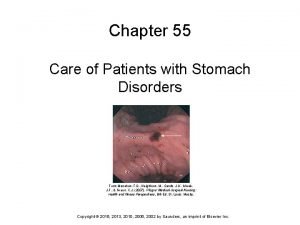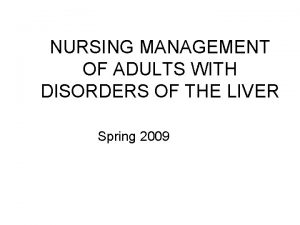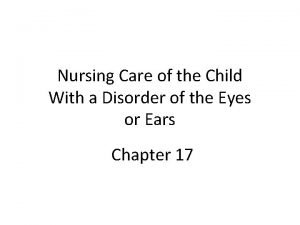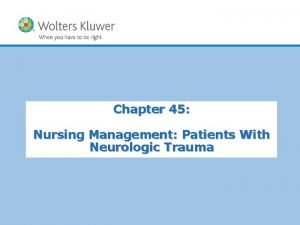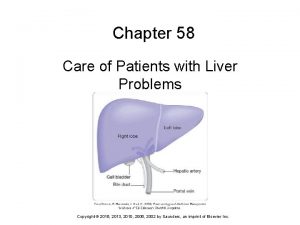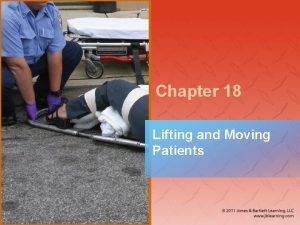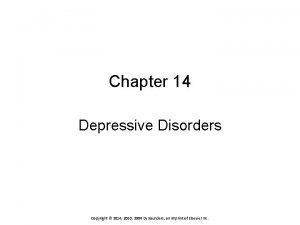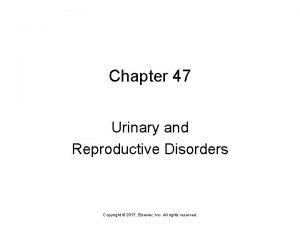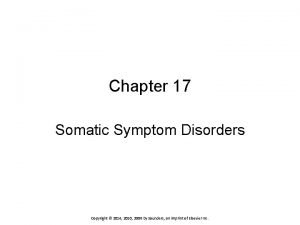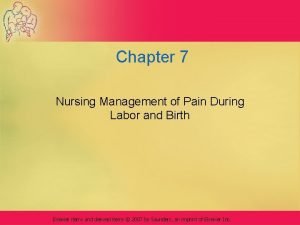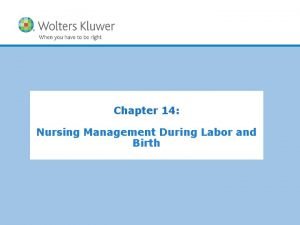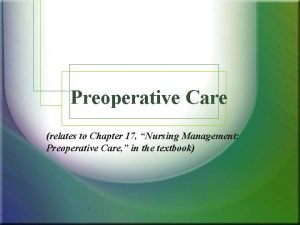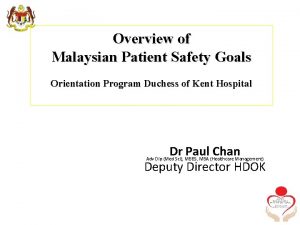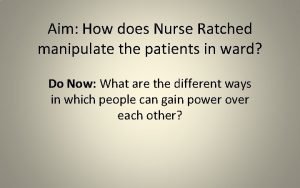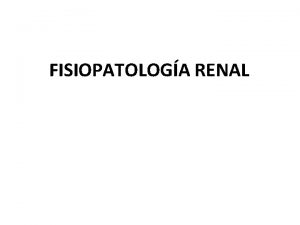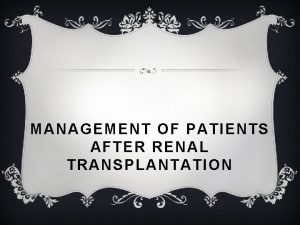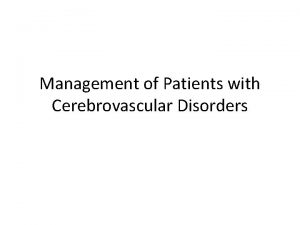Chapter 27 Nursing Management Patients With Renal Disorders





































































- Slides: 69

Chapter 27 Nursing Management: Patients With Renal Disorders Copyright © 2013 Wolters Kluwer Health | Lippincott Williams & Wilkins

Acute Glomerulonephritis • Inflammation of the glomerular capillaries • Manifestations include hematuria, edema, azotemia (excessive nitrogenous wastes in the blood), and proteinuria • Treatment involves protein and sodium restriction and antibiotic administration • Complications include hypertensive encephalopathy, heart failure, and pulmonary edema Copyright © 2013 Wolters Kluwer Health | Lippincott Williams & Wilkins

Question A nurse is providing care for a patient with acute glomerulonephritis. Which of the following assessments should the nurse prioritize? A. Daily weights B. Ankle-brachial index C. Pain assessment D. Blood glucose levels Copyright © 2013 Wolters Kluwer Health | Lippincott Williams & Wilkins

Answer Rationale: A patient with acute glomerulonephritis is susceptible to fluid volume excess. The most accurate indicator of fluid loss or gain in an acutely ill patient is weight, as accurate intake and output and assessment of insensible losses may be difficult. Blood sugars, ABI, and pain assessment do not address the main manifestations and complications of the disease. Copyright © 2013 Wolters Kluwer Health | Lippincott Williams & Wilkins

Chronic Glomerulonephritis • Characterized by proteinuria, usually caused by repeated episodes of glomerular injury that results in renal destruction and broad manifestations • Major complication is chronic renal failure or end-stage renal disease (ESRD) • Assessment priorities include fluid and electrolyte status, cardiac status, and neurologic status Copyright © 2013 Wolters Kluwer Health | Lippincott Williams & Wilkins

Nephrotic Syndrome • A cluster of clinical findings that can occur with almost any intrinsic renal disease or systemic disease that affects the glomerulus • Diabetic nephropathy is the most common cause and results in proteinuria • Treated with medication and dietary modification Copyright © 2013 Wolters Kluwer Health | Lippincott Williams & Wilkins

Acute Renal Failure (ARF) • A typically reversible clinical syndrome in which there is an abrupt loss of kidney function and GFR over a period of hours to days • Types: – Prerenal ARF: Caused by reduced blood flow to the kidney – Intrarenal ARF: The result of parenchymal damage to the glomeruli or kidney tubules – Postrenal ARF: The result of an obstruction • Four clinical phases of ARF: Initiation or onset, oliguric, diuretic, and recovery Copyright © 2013 Wolters Kluwer Health | Lippincott Williams & Wilkins

Question Is the following statement true or false? An older adult with benign prostatic hyperplasia (BPH) is at risk for the postrenal type of ARF. Copyright © 2013 Wolters Kluwer Health | Lippincott Williams & Wilkins

Answer Rationale: Postrenal ARF is the result of an obstruction that develops anywhere from the collecting ducts of the kidney to the urethra. This results from ureteral blockage, such as from bilateral renal calculi or benign prostatic hypertrophy (BPH). Copyright © 2013 Wolters Kluwer Health | Lippincott Williams & Wilkins

ARF cont’d • Multisystemic manifestations are present, requiring multiple laboratory tests. • Interventions include: – Medications – Nutritional promotion – Bed rest – Infection control – Skin care Copyright © 2013 Wolters Kluwer Health | Lippincott Williams & Wilkins

Chronic Renal Failure (CRF) and End. Stage Renal Disease (ESRD) • A progressive and irreversible deterioration in renal function taking place over months to years • The end products of protein metabolism, normally excreted in urine, accumulate in the blood • Major risk factors include diabetes, hypertension, proteinuria, family history, and increasing age • Virtually every body system is affected by chronic renal failure Copyright © 2013 Wolters Kluwer Health | Lippincott Williams & Wilkins

CRF and ESRD (cont’d) • Medications include phosphate-binding agents, calcium supplements, antihypertensive and cardiac medications, antiseizure medications, and erythropoietin. • Patients require nutritional support and dialysis Copyright © 2013 Wolters Kluwer Health | Lippincott Williams & Wilkins

Arteriovenous Fistula https: //www. youtube. com/watch? v=O_Z 75 Bjhob. M Copyright © 2013 Wolters Kluwer Health | Lippincott Williams & Wilkins

Hemodialysis Copyright © 2013 Wolters Kluwer Health | Lippincott Williams & Wilkins

Peritoneal Dialysis Copyright © 2013 Wolters Kluwer Health | Lippincott Williams & Wilkins

Continuous Ambulatory Peritoneal Dialysis Copyright © 2013 Wolters Kluwer Health | Lippincott Williams & Wilkins

Dialysis How Does Dialysis Work https: //www. youtube. com/watch? v=f. Kl. Y 2 SKi_dk Dialysis Treatment Procedure https: //www. youtube. com/watch? v=E 8 Uj-C 1 -Hy. U Copyright © 2013 Wolters Kluwer Health | Lippincott Williams & Wilkins

Hemodialysis (cont’d) • Vascular access is achieved by a temporary device, an arteriovenous fistula, or an arteriovenous graft • During dialysis, the patient, the dialyzer, and the dialysate bath require constant monitoring for complications • Medications, fluid balance, and nutritional needs must be addressed • The patient is at risk of several complications Copyright © 2013 Wolters Kluwer Health | Lippincott Williams & Wilkins

Question A patient with ESRD is scheduled to begin a hemodialysis treatment. The dialysis nurse should be aware that the patient will be vulnerable to: A. Urosepsis B. Abdominal pain C. Hypotension D. Metabolic alkalosis Copyright © 2013 Wolters Kluwer Health | Lippincott Williams & Wilkins

Answer Rationale: The patient undergoing hemodialysis is vulnerable to hypotension because of the sudden alteration in normal blood flow and fluid balance. Urosepsis, abdominal pain, and alkalosis are not among the most common complications of dialysis. Copyright © 2013 Wolters Kluwer Health | Lippincott Williams & Wilkins

Kidney Transplantation • The treatment of choice for most patients with ESRD • Preoperative management goals include bringing the patient’s metabolic state to a level close to normal, making sure that the patient is free of infection, and initiating immunosuppressants • Postoperative care priorities are: – Administering medications – Assessing for rejection – Preventing infection – Monitoring urinary function Copyright © 2013 Wolters Kluwer Health | Lippincott Williams & Wilkins

Question A patient waiting for a kidney transplant asks the nurse what signs and symptoms most likely indicate rejection. What would be the nurse's best response? A. “Low urine output can be a sign of rejection. ” B. “Shortness of breath is often a sign of rejection. ” C. “Decreasing blood pressure is a sign of rejection. ” D. “Weight loss is a sign of rejection. ” Copyright © 2013 Wolters Kluwer Health | Lippincott Williams & Wilkins

Answer Rationale: After kidney transplantation, the nurse assesses the patient for signs and symptoms of transplant rejection: oliguria, edema, fever, increasing blood pressure, weight gain, and swelling or tenderness over the transplanted kidney or graft. Copyright © 2013 Wolters Kluwer Health | Lippincott Williams & Wilkins

Renal Trauma • The most common renal injuries are contusions, lacerations, ruptures, and renal pedicle injuries or small internal lacerations • Even a fairly small renal laceration can produce massive bleeding • Goals of management are to control hemorrhage and pain, and prevent infection, as well as to preserve and restore renal function Copyright © 2013 Wolters Kluwer Health | Lippincott Williams & Wilkins

NCLEX-Style Review Questions Which of the following assessment findings would the nurse anticipate in a patient with ARF? a. Hypomagnesemia b. Hypercalcemia c. Hyperkalemia d. Hyperchloremia Copyright © 2013 Wolters Kluwer Health | Lippincott Williams & Wilkins

NCLEX-Style Review Questions Rationale: Typical metabolic and electrolyte abnormalities in renal failure included hyperkalemia, hypermagnesemia, hypocalcemia secondary to hyperphosphatemia, and hypochloremia with dilutional hyponatremia. Copyright © 2013 Wolters Kluwer Health | Lippincott Williams & Wilkins

NCLEX-Style Review Questions When caring for the patient with chronic renal failure, the nurse teaches the patient to manage his diet by avoiding which of the following foods? a. Green leafy vegetables and citrus b. Apples and pears c. Proteins of high biologic value d. Oat-, wheat-, and rye-containing products Copyright © 2013 Wolters Kluwer Health | Lippincott Williams & Wilkins

NCLEX-Style Review Questions Rationale: The patient should avoid potassium-containing foods such as citrus and green leafy vegetables. Apples and pears are not potassium-containing foods. Proteins are restricted, but those taken should be of high biologic value. Carbohydrates are encouraged to prevent ketosis; therefore, oats, wheat, and rye are acceptable. Copyright © 2013 Wolters Kluwer Health | Lippincott Williams & Wilkins

NCLEX-Style Review Questions The nurse recognizes the patient will recognize the signs and symptoms of renal transplant rejection when the patient states he will monitor for which of the following? a. Thrill and bruit over the fistula b. Weight gain and fever c. Palpitations and thirst d. Flank pain and pyuria Copyright © 2013 Wolters Kluwer Health | Lippincott Williams & Wilkins

NCLEX-Style Review Questions Rationale: Symptoms of transplant rejection include fever, weight gain, leukocytosis, tenderness over the graft site, and returning symptoms of uremia. Thrill and bruit over the fistula indicate a positive outcome for the fistula. Palpitations and thirst may be symptoms of fluid volume deficit, which is not found in the renal failure patient. Flank pain and pyuria are symptoms of pyelonephritis. Copyright © 2013 Wolters Kluwer Health | Lippincott Williams & Wilkins

NCLEX-Style Review Questions When planning care for the patient with kidney trauma, the nurse notifies the physician immediately for which of the following? a. Laboratory reports microscopic hematuria b. Tachycardia and hypotension c. Patient is upset and crying d. Scar noted on patient’s left flank Copyright © 2013 Wolters Kluwer Health | Lippincott Williams & Wilkins

NCLEX-Style Review Questions Rationale: Tachycardia and hypotension are symptoms of hemorrhagic shock for which the nurse must notify the health care provider. Hematuria appears in renal trauma and other illnesses, but it is expected rather than emergency. A scar on the flank and crying would not require medical intervention. Copyright © 2013 Wolters Kluwer Health | Lippincott Williams & Wilkins

NCLEX-Style Review Questions Which of the following reflects appropriate teaching to prevent long-term complications for the patient with nephrotic syndrome? a. Observe for dark urine and clay-colored stool. b. Void every 2 hours on schedule. c. Avoid driving at night. d. Minimize your intake of saturated fat. Copyright © 2013 Wolters Kluwer Health | Lippincott Williams & Wilkins

NCLEX-Style Review Questions Rationale: The patient with nephritic syndrome is at risk for cardiovascular disease. Dark urine and clay-colored stool are symptoms of hepatic or biliary diseases. Voiding every 2 hours and avoiding driving at night are not pertinent to the nephritic syndrome. Copyright © 2013 Wolters Kluwer Health | Lippincott Williams & Wilkins

Chapter 28 Nursing Management: Patients With Urinary Disorders Copyright © 2013 Wolters Kluwer Health | Lippincott Williams & Wilkins

Infections of the Lower Urinary Tract • Cystitis: Inflammation of the bladder • Bacterial prostatitis: Inflammation of the prostate • Bacterial urethritis: Inflammation of the urethra • Bacteria enter the urinary tract: – By the transurethral route (ascending infection; most common) – Through the bloodstream (hematogenous spread) – By means of a fistula (direct extension) Copyright © 2013 Wolters Kluwer Health | Lippincott Williams & Wilkins

Lower Urinary Tract Infections (UTIs) (cont’d) • Symptoms include dysuria (painful or difficult urination), burning on urination, frequency, urgency, nocturia (excessive urination at night), incontinence, and suprapubic or pelvic pain: – Older adults often have an atypical presentation • Diagnosed with urine cultures and sensitivities • Management includes antibiotics and patient education Copyright © 2013 Wolters Kluwer Health | Lippincott Williams & Wilkins

Question Is the following statement true or false? In order to minimize the risk of antibiotic resistance, patients with a UTI should be encouraged to discontinue their antibiotics as soon as symptoms resolve. Copyright © 2013 Wolters Kluwer Health | Lippincott Williams & Wilkins

Answer Rationale: It is important for patients to complete their prescribed course of antibiotics, regardless of the absence of symptoms. Doing so minimizes the risk of antibiotic resistance. Copyright © 2013 Wolters Kluwer Health | Lippincott Williams & Wilkins

Upper UTIs • Pyelonephritis: A bacterial infection of the renal pelvis, tubules, and interstitial tissue of one or both kidneys • Causes are the ascending spread of bacteria from the bladder or proliferation of bacteria from systemic sources • May be acute or chronic • Both require treatment with antibiotics to prevent endstage renal disease (ESRD) Copyright © 2013 Wolters Kluwer Health | Lippincott Williams & Wilkins

Dysfunctional Voiding Patterns: Urinary Incontinence • Affects people of all ages but is particularly common among the elderly • Usually accompanied by overactive bladder Copyright © 2013 Wolters Kluwer Health | Lippincott Williams & Wilkins

Types of Incontinence • Stress incontinence: Involuntary loss of urine as a result of sneezing, coughing, or changing position • Urge incontinence: The involuntary loss of urine associated with a strong urge to void • Reflex incontinence: The involuntary loss of urine due to hyperreflexia • Overflow incontinence: The involuntary loss of urine associated with overdistention of the bladder • Functional incontinence: Lower urinary tract function is affected by factors such as cognitive impairment • Iatrogenic incontinence: Loss of urine due to extrinsic medical factors, predominantly medications Copyright © 2013 Wolters Kluwer Health | Lippincott Williams & Wilkins

Question A 36 -year-old woman has sought care because she has begun having sporadic episodes of incontinence when she runs hard while playing soccer. This woman most likely has: A. Urge incontinence B. Functional incontinence C. Stress incontinence D. Iatrogenic incontinence Copyright © 2013 Wolters Kluwer Health | Lippincott Williams & Wilkins

Answer Rationale: Stress incontinence is the involuntary loss of urine through an intact urethra as a result of sneezing, coughing, or motion. It predominantly affects women who have had vaginal deliveries and is thought to be the result of decreasing ligament and pelvic floor support (pelvic floor dysfunction) of the urethra. Vigorous physical activity often precipitates the loss of urine in these patients. This pattern is not typical of iatrogenic, urge, or functional incontinence. Copyright © 2013 Wolters Kluwer Health | Lippincott Williams & Wilkins

Management of Incontinence • Management depends on the type of urinary incontinence and its causes • Behavioral therapies are the first choice • Pharmacologic therapy works best when used as an adjunct to behavioral interventions • Surgery may be indicated when behavioral and pharmacologic therapy has been ineffective • Nursing management is based on the premise that incontinence is not inevitable with illness or aging and that it is often reversible and treatable Copyright © 2013 Wolters Kluwer Health | Lippincott Williams & Wilkins

Urinary Retention • The inability to empty the bladder completely during attempts to void • Residual urine is urine that remains in the bladder after voiding • Multiple causes, so thorough assessment is necessary • Complications include renal calculi (urolithiasis or nephrolithiasis), pyelonephritis, and sepsis • In the case of acute urinary retention, decompression with a urethral catheter is commonly required • Nursing care aims to encourage normal voiding patterns Copyright © 2013 Wolters Kluwer Health | Lippincott Williams & Wilkins

Question Is the following statement true or false? The presence of any residual urine is an abnormal assessment finding that necessitates medical and nursing interventions. Copyright © 2013 Wolters Kluwer Health | Lippincott Williams & Wilkins

Answer Rationale: Not every patient achieves complete bladder emptying. In a healthy adult younger than 60 years, complete bladder emptying should occur with each voiding. In adults older than 60 years, 50 to 100 m. L of residual urine may remain after each voiding because of the decreased contractility of the detrusor muscle. Copyright © 2013 Wolters Kluwer Health | Lippincott Williams & Wilkins

Neurogenic Bladder • Dysfunction that results from a lesion of the nervous system and leads to urinary incontinence • Two types: Spastic (or reflex) bladder and flaccid bladder • Interventions include continuous or intermittent selfcatheterization, use of an external condom-type catheter, a diet low in calcium to prevent calculi, and encouragement of mobility and ambulation Copyright © 2013 Wolters Kluwer Health | Lippincott Williams & Wilkins

Catheterization • A patient should be catheterized only if necessary, because instrumentation can lead to UTI • When an indwelling catheter cannot be avoided, a closed drainage system is essential • Suprapubic catheterization allows bladder drainage by inserting a catheter or tube into the bladder through a suprapubic (above the pubis) incision or puncture Copyright © 2013 Wolters Kluwer Health | Lippincott Williams & Wilkins

Nursing Care: The Patient With an Indwelling Catheter • Assessment of the patient and the system • Prevention of infection • Minimizing trauma • Retraining the bladder • Assisting with intermittent self-catheterization (ISC) Copyright © 2013 Wolters Kluwer Health | Lippincott Williams & Wilkins

Calculi • Urolithiasis: Stones in the urinary tract • Nephrolithiasis: Stones in the kidneys • Stones are formed when urinary concentrations of calcium oxalate, calcium phosphate, and uric acid increase • Signs and symptoms depend on the presence of obstruction, infection, and edema, but pain is common • Medical interventions include ureteroscopy, extracorporeal shock wave lithotripsy (ESWL), or endourologic (percutaneous) stone removal Copyright © 2013 Wolters Kluwer Health | Lippincott Williams & Wilkins

Nursing Process: The Patient With Urinary Calculi • Assessment often reveals pain, nausea, vomiting, diarrhea, and abdominal distention • Goals and interventions address relief of pain, prevention of recurrence, and absence of complications Copyright © 2013 Wolters Kluwer Health | Lippincott Williams & Wilkins

Question An elderly man has been brought to the emergency room with recent episodes of confusion and periods of incontinence. What condition would the nurse suspect the patient had? A. Urinary retention B. Urinary trauma C. Urinary calculi D. Urinary tract infection Copyright © 2013 Wolters Kluwer Health | Lippincott Williams & Wilkins

Answer Rationale: Elderly patients often lack the typical symptoms of UTI and sepsis. Although frequency and urgency may occur, nonspecific symptoms, such as cognitive changes, lethargy, anorexia, new incontinence, hyperventilation, and low-grade fever, may be the only clues. This presentation is less likely to result from calculi or trauma. Copyright © 2013 Wolters Kluwer Health | Lippincott Williams & Wilkins

Genitourinary Trauma • Urethral trauma • Ureteral trauma • Bladder trauma • The patient with genitourinary trauma should be assessed frequently • Surgery is often required: – Patients can be instructed about care of the incision and the importance of an adequate fluid intake Copyright © 2013 Wolters Kluwer Health | Lippincott Williams & Wilkins

Cancer of the Bladder • Painless gross hematuria is the most common symptom • Treatments include medications, radiation, or surgery • Creation of a urinary diversion is often necessary: – Cutaneous urinary diversion: Urine drains through an opening created in the abdominal wall and skin – Continent urinary diversion: A portion of the intestine is used to create a new reservoir for urine – Both require vigilant nursing care Copyright © 2013 Wolters Kluwer Health | Lippincott Williams & Wilkins

Cutaneous Urinary Diversions Copyright © 2013 Wolters Kluwer Health | Lippincott Williams & Wilkins

Continent Urinary Diversions Copyright © 2013 Wolters Kluwer Health | Lippincott Williams & Wilkins

NCLEX-Style Review Questions A sexually-active, 23 -year-old woman presents with a history of three UTIs in the past 12 months. What is the first step in her evaluation? a. A urine culture b. An intravenous pyelogram to look for an anatomic abnormality c. A history and physical examination d. A 3 -day course of antibiotics Copyright © 2013 Wolters Kluwer Health | Lippincott Williams & Wilkins

NCLEX-Style Review Questions Rationale: As with any disease process, a history and physical exam is the first step. Copyright © 2013 Wolters Kluwer Health | Lippincott Williams & Wilkins

NCLEX-Style Review Questions A 55 -year-old woman reports stress incontinence when sneezing and playing tennis. She asks what she can do to prevent this from happening. Which of the following is the nurse’s best response? a. Start an anticholinergic medication. b. Void immediately prior to playing tennis to try and decrease urine loss while playing. c. Decrease overall fluid intake so this is unlikely to happen at any time. d. Restrict intake of calcium-containing foods. Copyright © 2013 Wolters Kluwer Health | Lippincott Williams & Wilkins

NCLEX-Style Review Questions Rationale: Behavioral modifications such as emptying the bladder can often successfully address mild stress incontinence. Copyright © 2013 Wolters Kluwer Health | Lippincott Williams & Wilkins

NCLEX-Style Review Questions Mrs. Andersen has an indwelling catheter after an open cholecystectomy. She develops cramping in the suprapubic area and urinary leakage. What is the nurse’s first intervention? a. Make certain the catheter is not kinked. b. Evaluate for incisional pain. c. Explain that her symptoms are due to peristalsis. d. Irrigate the urinary catheter to assess for blockage of flow. Copyright © 2013 Wolters Kluwer Health | Lippincott Williams & Wilkins

NCLEX-Style Review Questions Rationale: A kinked catheter most easily explains her symptoms and is not an uncommon cause for leakage and bladder spasms, as it irritates the bladder. Copyright © 2013 Wolters Kluwer Health | Lippincott Williams & Wilkins

NCLEX-Style Review Questions Traci, a 29 -year-old married woman, frequently experiences a UTI after sexual intercourse. In addition to instruction regarding voiding after intercourse, her initial management may include which of the following? a. A recommendation for abstinence b. Testing for anatomic abnormalities c. A prescription for antibiotics to be used post-coitus d. Boric acid suppositories Copyright © 2013 Wolters Kluwer Health | Lippincott Williams & Wilkins

NCLEX-Style Review Questions Rationale: Many women will be placed on antibiotics. A single dose postcoitus is often successful at preventing ascending infections. Copyright © 2013 Wolters Kluwer Health | Lippincott Williams & Wilkins

NCLEX-Style Review Questions When being instructed on methods for managing the mucous in their urinary diversion, patients should be reminded to do which of the following? a. Increase fiber intake. b. Consume high levels of citrus fruits and juices. c. Increase consumption of cranberry juice. d. Avoid caffeine consumption. Copyright © 2013 Wolters Kluwer Health | Lippincott Williams & Wilkins

NCLEX-Style Review Questions Rationale: Cranberry juice helps to acidify the urine and manage mucous production. Copyright © 2013 Wolters Kluwer Health | Lippincott Williams & Wilkins
 Ira pré renal renal e pós renal
Ira pré renal renal e pós renal Diagnostico etiologico
Diagnostico etiologico Nursing care of male patients with genitourinary disorders
Nursing care of male patients with genitourinary disorders Chapter 55 care of patients with stomach disorders
Chapter 55 care of patients with stomach disorders Distinguish between renal corpuscle and renal tubule
Distinguish between renal corpuscle and renal tubule Nursing management of sleep disorders
Nursing management of sleep disorders Nursing management of gastrointestinal disorders
Nursing management of gastrointestinal disorders Nursing position for patients
Nursing position for patients Nursing intervention of cataract
Nursing intervention of cataract Nursing intervention for ocd
Nursing intervention for ocd Esophageal varices nursing management
Esophageal varices nursing management Ventriculostomy care nursing
Ventriculostomy care nursing Hirschberg test
Hirschberg test Pneumatic reduction of intussusception
Pneumatic reduction of intussusception Lippincott williams
Lippincott williams Management of patients with neurologic trauma
Management of patients with neurologic trauma Non-infective
Non-infective Tracheostomy stoma
Tracheostomy stoma Chapter 8 lifting and moving patients
Chapter 8 lifting and moving patients Lifting and moving patients
Lifting and moving patients Chapter 58 care of patients with liver problems
Chapter 58 care of patients with liver problems Short backboards are usually used to
Short backboards are usually used to Medical model psychology
Medical model psychology Concept mapping chapter 11 genetic disorders
Concept mapping chapter 11 genetic disorders Chapter 8 skin disorders and diseases
Chapter 8 skin disorders and diseases Chapter 6 musculoskeletal system
Chapter 6 musculoskeletal system Chapter 46 digestive and endocrine disorders
Chapter 46 digestive and endocrine disorders Chapter 29 somatic symptom and dissociative disorders
Chapter 29 somatic symptom and dissociative disorders Chapter 29 endocrine and metabolic disorders
Chapter 29 endocrine and metabolic disorders Chapter 21 mental health diseases and disorders
Chapter 21 mental health diseases and disorders Chapter 18 psychological disorders
Chapter 18 psychological disorders Chapter 18 eating and feeding disorders
Chapter 18 eating and feeding disorders Chapter 17 reproductive system diseases and disorders
Chapter 17 reproductive system diseases and disorders Chapter 15 nervous system diseases and disorders
Chapter 15 nervous system diseases and disorders Chapter 15 anxiety and obsessive-compulsive disorders
Chapter 15 anxiety and obsessive-compulsive disorders Chapter 14 psychological disorders
Chapter 14 psychological disorders Chapter 14 depressive disorders
Chapter 14 depressive disorders Chapter 11 childhood and neurodevelopmental disorders
Chapter 11 childhood and neurodevelopmental disorders Impulse control problems
Impulse control problems Chapter 8 skin disorders and diseases
Chapter 8 skin disorders and diseases Chapter 5 lesson 4 getting help answer key
Chapter 5 lesson 4 getting help answer key Bruised nail beds milady
Bruised nail beds milady Milady chapter 10 nail disorders and diseases
Milady chapter 10 nail disorders and diseases Cardiovascular system diseases and disorders chapter 8
Cardiovascular system diseases and disorders chapter 8 Milady chapter 8 skin disorders and diseases
Milady chapter 8 skin disorders and diseases Chapter 14 psychological disorders
Chapter 14 psychological disorders Ap psychology chapter 15 psychological disorders
Ap psychology chapter 15 psychological disorders Chapter 47 urinary and reproductive disorders
Chapter 47 urinary and reproductive disorders Chapter 17 somatic symptom disorders
Chapter 17 somatic symptom disorders Chapter 12 schizophrenia spectrum disorders
Chapter 12 schizophrenia spectrum disorders Chapter 11 lesson 2 body image and eating disorders
Chapter 11 lesson 2 body image and eating disorders Chapter 10 lymphatic system diseases and disorders
Chapter 10 lymphatic system diseases and disorders Is schizophrenia on a spectrum
Is schizophrenia on a spectrum Chapter 7 nursing management of pain during labor and birth
Chapter 7 nursing management of pain during labor and birth Chapter 14 nursing management during labor and birth
Chapter 14 nursing management during labor and birth Chapter 17 preoperative nursing management
Chapter 17 preoperative nursing management Modular nursing
Modular nursing Definition of nursing diagnosis
Definition of nursing diagnosis Nursing process in psychiatric nursing
Nursing process in psychiatric nursing Life expectancy of sickle cell patients
Life expectancy of sickle cell patients Perimylolysis
Perimylolysis Factors of care patients can expect to receive
Factors of care patients can expect to receive Patients rights charter
Patients rights charter Malaysian patient safety goals 2021
Malaysian patient safety goals 2021 Nurse leader rounding questions
Nurse leader rounding questions Dr carlson advises his depressed patients
Dr carlson advises his depressed patients How does nurse ratched manipulate the patients
How does nurse ratched manipulate the patients Types of admission in nursing
Types of admission in nursing Moving and handling dementia patients
Moving and handling dementia patients Leader rounding
Leader rounding



